Bock Water heaters PowerGas 51PG User manual
- Category
- Water heaters & boilers
- Type
- User manual
This manual is also suitable for

WARNING
Improper installation, adjustment, alteration,
service or maintenance can cause serious in-
jury or property damage. Refer to this manual.
For assistance or additional information, con-
sult a qualified installer or service agency.
WARNING
If the information in these instructions is not
followed exactly, a fire or explosion may result
causing property damage, personal injury or
death.
WARNING
Do not install on combustible flooring. Install
in accordance with all local codes. In the
absence of local codes, refer to NFPA 54 or
ANSI Z21.10.1.
CAUTION
The recommended temperature for normal resi-
dential use is 120°F. The dial on the aquastat
does not always reflect the out-coming water
temperature and it could occasionally exceed
120°F. Variation in out-coming temperature
could be based on factors including but not
limited to usage patterns and type of installa-
tion. Test water at the tap nearest to the water
heater. (See page 8 for measuring the out-
coming water temperature.)
WARNING
Hotter water increases the risk of scald injury.
Before adjusting the water temperature setting,
read this instruction manual. Temperatures at
which injury occurs vary with the person’s age
and the length of exposure. The slower reac-
tion time of children, elderly or physically or
mentally challenged persons increases the
scalding hazard to them. It is recommended
that lower water temperatures be used where
these exposure hazards exist. Households with
small children or invalids may require a tem-
perature setting less than 120°F to prevent acci-
dental contact with hot water. To produce
less than 120°F, use point-of-use tempera-
ture limiting devices.
If higher water temperature is needed in part
of the water system, automatic temperature
limiting devices must be used on all lines to
water taps.
WARNING
Flammable vapors may be drawn to this water
heater from other areas of the structure by air
currents. Do not store or use any flammable
liquids in the vicinity of this heater.
WARNING
Water heater blankets may restrict air flow to
the water heater and cause fire, asphyxiation,
personal injury or death.
THIS MANUAL HAS BEEN PREPARED TO
ACQUAINT YOU WITH THE INSTALLATION,
OPERATION, AND MAINTENANCE OF YOUR
WATER HEATER AND TO PROVIDE IMPORTANT
SAFETY INFORMATION.
Read all instructions thoroughly before at-
tempting installation or operation of your
water heater. Keep these instructions for future
reference.
Local plumbing and electrical codes must be
followed in the installation of this water
heater. In the absence of a local code use the
UNIFORM PLUMBING CODE and the NFPA
Code. Local codes may supersede instructions
in this installation manual.
These instructions are a guide for the correct
installation of the water heater. The manufac-
turer will not be liable for damages caused by
failure to comply with the installation and
operating instructions outlined on the
following pages.
If you lack the necessary skills required or have
difficulty following the directions, seek help
from a qualified person for that part of the
installation you do not understand.
FAILURE TO FOLLOW THESE INSTRUCTIONS
OR ALL APPLICABLE BUILDING CODES
AND REGULATIONS VOIDS THE WARRANTY
ON THIS WATER HEATER.
Warranty, Registration Card and Parts List are included.
Homeowner: Please remember to return the Registration Card!
To the Consumer:
Please read these and all component
instructions and keep for future reference.
To the Installer:
Please attach these instructions
next to the water heater.
Power Gas
Instruction Manual

POWER GAS
Instruction Manual
Page 2 Power Gas
HOT OUTLET
C
D
B
AUXILIARY OUTLET
(COMBINED APPLIANCE)
COLD INLET
AQUASTAT
RETURN
A
E
Storage Capacity
(gal.)
BTUH (Thousands)
Minimum
Gas Connection
Hot Outlet
Temperature Rise (F)
Weight (lbs.)
(Non ASME)
HOT OUTLET*
AQUASTAT
B
C
HIGH LIMIT 50, 73, 120, 190, 241, 361, 541
COLD INLET (EXCLUDES MODEL 541)
RETURN FOR MODELS
120, 190, 241 & 361
MODEL 541 (INLET/RETURN)
RETURN
32, 51,
71, 72,
73
E
A
D
Return
Cold Inlet
Recovery (GPH)
B
D
32 PG 32 104 1⁄23⁄4'' 3⁄4'' 3⁄4'' 90° 110 51'' 20'' 6'' 11'' 17'' 120/60 260
33 PG 33 104 1⁄23⁄4'' 3⁄4'' 3⁄4'' 90° 109 431⁄4" 24'' 6'' N/A 171⁄4'' 120/60 270
40 PG 40 126 1⁄23⁄4'' 3⁄4'' 1'' 90° 134 61'' 20'' 6'' 54'' 18'' 120/60 295
50 ESPG 50 140 1⁄21" 11⁄2"1
1⁄2" 90° 142 52" 26" 6" 131⁄2" 181⁄2" 120/60 345
51 PG 50 152 1⁄21'' 1'' 3⁄4'' 90° 159 59'' 24'' 6'' 11'' 18'' 120/60 330
71 PG 68 173 1⁄21" 11⁄2"1
1⁄2" 90° 170 66" 26" 6" 131⁄2" 22" 120/60 395
72 PG 67 199 1⁄21" 11⁄2"1
1⁄2" 90° 204 58" 28" 8" 16" 19" 120/60 560
73 PG 67 242 3⁄41" 11⁄2"1
1⁄2" 90° 247 58" 28" 8" 16" 19" 120/60 560
120 PG 113 155 1⁄21'' 2'' 2'' 90° 160 67'' 311⁄2'' 6'' 19'' 22'' 120/60 700
190 PG 113 190 1⁄21'' 2'' 2'' 90° 191 67'' 311⁄2'' 6'' 19'' 22'' 120/60 700
241 PG 109 277 3⁄41" 2" 2" 90° 283 67" 311⁄2" 8" 19" 22" 120/60 935
361 PG 91 385 3⁄41" 2" 2" 90° 435 67" 311⁄2" 9" 23" 26" 120/60 1110
541 PG 83 623 1" 2" 2" 2" 90° 627 66" 34" 10" N/A 301⁄2" 120/60 1350
Voltage (V/Hz)
Dimensions
32, 50, 51, 71, 72, 73, 120, 190, 241, 361, 541 PG 33, 40 PG
A
C
E
*nipples not supplied on all models
(inc. burner
and controls)

Midco burner w/ Carlin EZ-Temp ( all models)
Power Flame burner w/ Carlin EZ-Temp ( only 541 PG)
WHEN YOU RECEIVE YOUR NEW WATER HEATER
Check the new equipment to see if all components are in good condition. The water heater and
burner may be shipped as separate units. The aquastat and immersion well are packed with the
burner. If damage is observed or parts appear to be missing, contact your wholesaler. A burner
installation and setup manual is also packed with the burner.
Power Gas Page 3
BURNER WIRE DIAGRAM
Carlin burner w/ Carlin EZ-Temp
Models 32, 33, 40, 50, 51, 71, 72, 73, 120, 190PG
Honeywell 4103A-1142 Honeywell L4006-2031, L8100C-1027
Models 32,33,40,51,71,72PG Models 50,73,120,190,241,361,541PG

Page 4 Power Gas
WATER HEATER PLACEMENT
NOTE: Locate the heater so it is not subject to physical damage from moving vehicles or
flooding. Do not locate the water heater in a room where swimming pool chemicals or large
quantities of water softener salt are kept. Installing a water heater
in this environment will result in premature failure of tank and
burner components due to corrosion caused by these elements
diffusing into the air.
DO NOT INSTALL THE WATER HEATER ON COMBUSTIBLE
FLOORING. Place on noncombustible flooring and maintain clear-
ances prescribed by this manufacturer and per code NFPA 54. If the
water heater must be located on combustible flooring it must be
raised off the floor with a layer of 4'' concrete block laid so the air
holes are aligned as shown in the drawing at left. Consult with local
code officials before using this method. Do not use on 541 PG.
Please consult local codes, NFPA 54 and/or contact Bock Water Heaters with questions concerning
proper flooring materials. Leave adequate room for periodic maintenance of heater and burner.
The water heater should be placed as near to the chimney as practical in order to keep vent con-
nector length to a minimum. Consult National Fuel Gas Code for proper vent configuration.
Minimum clearance to combustible construction is: SIDES 6"; BACK 6"; FRONT 24";
BAROMETRIC DRAFT REGULATOR, 18". The installation of this water heater must
conform with local codes and ordinances. In the absence of local codes, the installa-
tion must comply with the National Fire Protection Association (NFPA 54) Code.
COMBUSTION AND VENTILATION AIR
The water heater must be installed in a location with an adequate air supply for combustion,
ventilation and draft control. Lack of an adequate air supply will result in poor burner/water
heater performance and nuisance lock outs. Unsafe levels of carbon monoxide (CO), conden-
sation and sooting may result if the room does not have an adequate air supply. See “National
Fuel Gas Code (NFPA 54)” or the discussions of “Unconfined Space” and “Confined Space”
below. Poor ventilation will also result in hot spots around the heater. Temperatures over 90°
near the water heater generally indicate a lack of ventilation.
UNCONFINED SPACE
Unconfined space in defined by NFPA 54 as a space with a volume greater than 50 cubic feet
(during typical use) per 1000 BTUH of the total combined input of all fuel burning appliances
in the space. Rooms leading directly to the installation space through doors that cannot be
closed can be considered part of the space. Exception: Buildings with full vapor barriers, tight
doors and windows or air infiltration rates of less than 0.35 air changes per hour will be consid-
ered a confined space and require additional air supplies.
CONFINED SPACE
Confined space is defined by NFPA 54 as a space with a volume less than 50 cubic feet (during
typical use) per 1000 BTUH of the total combined input of all fuel burning appliances in the
space. Buildings or rooms of unusually tight construction are also considered a confined space.
See “Unconfined Space: Exception”.
When installing fuel burning appliances in a confined space, air must be supplied to that
space from either inside or outside of the building as conditions allow.
A. Inside Air Supply: A confined space shall be provided with two permanent openings; one
within 12 inches of the top and one within 12 inches of the bottom of the enclosure. These
openings shall lead directly to room(s) of sufficient volume so that the combined volume of
all the space meets the criteria for unconfined space. Each opening shall have a minimum
free area of 1 square inch per 1000 Btu/hr of the combined total input of all fuel burning

appliances in the space. Each opening shall have an area of not less than 100 square inches or
a minimum dimension of not less than 3 inches.
B. Outside Air Supply: Confined spaces shall be provided with two permanent openings;
one within 12 inches of the top and one within 12 inches of the bottom of the enclosure.
These openings shall communicate directly, or by ducts, with the outdoors or spaces that
communicate with the outdoors.
1. Leading directly to the outside or through vertical ducts: Each opening shall have a
minimum free area of one square inch per 4000 Btu/hr of total input rating of all equip-
ment in the enclosure.
2. Leading to outside through horizontal ducts: Each opening shall have a minimum free
area of one square inch per 2000 Btu/hr of total input rating of all equipment in the
enclosure. Note: All ducts shall have the same cross sectional area as the free area of each
opening to which they connect. The minimum dimensions of all ducts shall not be less
than three inches. Powered combustion air supplies are also commercially available and
may be used.
LOUVERS & GRILLES
In calculating the free area of an opening, consideration must be given to the blocking effects
of louvers or grilles protecting the opening. Any screens used must be no finer than 1⁄4inch
mesh. If the free area of a louver or grille is known, this should be used in calculating the size
of opening required. If free area is unknown, it may be assumed that wood louvers will have
20 to 25% free area and metal louvers and grilles will have 60 to 75% free area. Louvers and
grilles should be fixed in the open position or interlocked with the equipment so that they
open automatically during equipment operation.
VENTING
The water heater shall be located as close to the chimney as practical. Long lateral runs will
result in intermittent combustion problems and unsafe operating conditions. Total vent
height should be a minimum of 6 feet. Shorter vent heights could result in unstable draft and
nuisance lock outs.
The venting system should be sized according to National Fuel Gas Code: NFPA 54/ANSI
Z223.1 (most recent edition) using the “Fan Min, Max” columns. If you do not have a copy of
this code one can be obtained at www.NFPA.org for a nominal fee. Copies of the NFPA venting
tables are also reprinted in the Bock Engineering Manual available from your Bock Represen-
tative or download from www.bockwaterheaters.com. Note: Do not reduce vent size more
than one size smaller than the vent connector supplied with the heater. B vent, L vent or
multi-fuel chimneys may be used. Single wall vent connectors may also be used.
When connecting to an existing vent system, examine the piping and system for condition.
Replace any sections that show signs of significant corrosion or have become perforated. Also
verify that the system is of the correct type and sized properly for the water heater and any
other appliances that are connected to it. Correct any discrepancies found between the exist-
ing system and current NFPA 54 code.
Draft must be controlled with a barometric damper or draft regulator approved for gas appli-
ances, normally supplied with each complete Bock Water Heater. (This device differs from a
vent/flue damper in that it precisely regulates the amount of room air entering the vent to control
draft. A vent/flue damper shuts off the vent during stand by periods to reduce losses and has no
effect of draft.) The draft regulator may be installed in a tee on top of the water heater and
must be adjusted while the water is running to regulate draft to a minimum of –0.02 inches
water column (WC) and a maximum of –0.05" WC. Draft over the fire should be slightly nega-
tive. Draft is normally adjusted by hanging washers (supplied with the draft regulator) on the
draft regulator chain. Follow the instruction supplied with the draft regulator for proper loca-
tion and draft adjustment procedures. Note: Failure to install the barometric damper or adjust
draft properly will result in unsafe operating conditions and nuisance burner lock outs.
Power Gas Page 5

If draft of –0.02" WC cannot be produced with an existing vent system, a draft inducer may be
required. Installations common vented with large vent hood equipped appliances such as
heating boilers may require vent dampers on the heating boiler connectors for proper vent
operation during summer months.
Check the building for items that can cause severe negative pressure problems such as large
exhaust fans. If these devices are installed in the same building check for their effect on draft
and combustion. All fuel burning appliances must be isolated from the effects of these devices
to operate properly. Failure to address this issue will result in unsafe operation and shorten
appliance life spans.
Your Bock Water Heater may also be operated with a power venter. The power venter must be
properly sized and adjusted to provide proper draft. Power venter wiring must turn on the
power venter on a call for heat and must prove venter operation before allowing the burner to
start. Refer to the power venter instructions for proper wiring and adjustment procedures.
CONNECT WATER PIPING
Connect cold inlet and hot outlet to fittings on top of water heater except models 33PG and
40PG. These models have cold water inlets located on the side of the tank. See drawing and
note below. Be careful not to apply any heat to the water heater nipples. Install dielectric
unions and shut off valves on both hot and cold water lines. Models 72PG through 541PG
have larger fittings located on the side of the tank or under the drain valve for use
as recirculation/return connections. Larger return fittings are optional on smaller models.
Alternatively recirculation/return lines can be plumbed to the cold water inlet.
33PG and 40PG models are equipped with a brass inlet
bushing installed in the tank. Heaters equipped with this
bushing are marked next to the inlet by the decal shown
on the left. The purpose of this bushing is to help keep the
tank bottom free of sediment by aiding tank flushing.
This bushing must be located as shown on the decal to
function properly. Do not allow the bushing to rotate out
of position when tightening the inlet fittings.
An approved pressure and temperature relief valve is factory installed in the opening provided
in the upper right-hand side of the water heater. Pipe the T&P valve outlet to within 6" of the
floor or to a floor drain with a free flowing drain pipe.
CAUTION: Scalding injury and/or water damage can occur from either the manual lifting
of the lever or the normal operation of the T&P valve if it is not piped to a proper drain.
If the valve fails to flow water or reseat, call your plumber.
Check incoming water line for backflow preventers or water pressure reducing valves, as these
may cause pressure to build up in the water heater and result in tank failure. If this water
heater is installed in a closed system or if backflow preventers and pressure regulators are
installed, a properly sized expansion tank must be installed.
Note: Do not try to heat hard water as this will drastically reduce heater life. Install a water
softener or other scale reducing water treatment system if the water heater is being installed in
a hard water area (water hardness higher than seven grains).
BURNER AND AQUASTAT INSTALLATION
Remove the cardboard core from the burner opening in the water heater. Inspect the burner
opening in the water heater and verify that the chamber is aligned with the burner opening
and has not shifted in shipment. Also verify that the chamber and insulation has not been
damaged in shipment. Some burner models are equipped with adjustable mounting flanges.
When installing these burner models measure the distance from the inside bottom edge of the
combustion chamber to the burner mounting bracket on the water heater jacket. Subtract 1⁄8"
from this measurement and locate the burner mounting flange that distance from the end of
Page 6 Power Gas

the burner tube. Secure the burner to the water heater with the bolts or nuts provided. When
retrofitting an existing burner to your Bock Power Gas heater, check the chart on page 12 for
proper settings and configuration. If the burner being installed is not on this list check with
your Bock representative to verify the appropriate application before installing.
The aquastat, high limit (if applicable) and well(s) are packed with the burner. In most cases
the wire harness will be pre-wired to the burner. If the harness is not wired to the burner refer
to the wire diagrams on page 3. Coat the threads of the well(s) with a suitable pipe thread
sealant and install the wells into the tank. Insert the sensing bulb(s) of the temperature
control into the well verifying that the bulb is fully inserted into the well. Fasten the
temperature control to the well.
CONNECT THE ELECTRICITY
Refer to the appropriate wire diagrams (page 3) and burner manual. All wiring must comply
with applicable codes and ordinances. Connect the power supply to the aquastat. Power
should run through a fused disconnect switch near the heater. See the burner manual for
correct wire and fuse sizes. This switch may be screwed to the water heater jacket if desired.
For Carlin EZ-Temp aquastats, attach the black (hot) wire to the red/white wire and the white
(neutral) wire to the white wire inside the EZ-Temp junction box. The harness from the EZ-
Temp to the burner will have three wires (red, black, white) for use with Carlin burners and
two wires (black, white) for use with Midco burners.
CONNECT THE GAS LINE
A manual gas valve, a union, and a sediment trap should all be provided in front of the gas
valve. All gas piping must conform to local codes and/or the National Fuel Gas Code; ANSI
223.1/NFPA 54 (Latest Edition). For LP installations refer to NFPA 58 (latest edition) for proper
gas piping.
Supply piping should be sized according to the charts found in the National Fuel Gas Code for
natural gas applications. Refer to NFPA 58 (latest edition) for pipe sizing recommendations for LP
installations. Also refer to the burner installation manual for gas line sizing recommendations.
Note: When sizing the gas piping to the heater, make sure that the pressure at the valve is
sufficient when all other appliances are operating. Be sure that the gas service and meter are
sized properly. Undersized gas piping will reduce water heater performance and life as well as
result in nuisance lock outs.
Gas piping should be carried oversize, i.e.: 3⁄4inch or 1 inch for 1⁄2inch valve to within 2 feet
of the valve itself. This sustains pressure at the valve during start-up to prevent flashbacks
caused by momentary pressure loss. For Carlin burners with natural gas or LP, 5” WC pressure
must be maintained upstream of the gas valve during operation. For Midco burners with nat-
ural gas, 6” WC pressure (EC 200/300) or 7” WC pressure (RE4400, RE4700) must be main-
tained upstream of the gas valve. For Midco burners with LP, 6” WC pressure (EC 200/300) or
5” WC pressure (RE4400, RE4700) must be maintained upstream. A 1⁄8inch NPT pipe connec-
tion should be installed upstream of the manual valve to check incoming gas pressure.
During pressure testing of the gas supply piping, close the manual gas shut-off valve to the
burner. Test pressure shall not exceed 1⁄2PSIG (14" WC). The gas valve is only rated for
1⁄2PSIG. To test at pressure greater than 1⁄2PSIG, close the manual shut-off valve and
disconnect the gas operating valve.
Turn on gas and inspect piping for leaks by “painting” each joint with soap and checking for
bubbles. Do not use open flame. The pipe thread compound that is used on gas piping must be
of the type resistant to propane gas. Do not use teflon tape on gas piping.
Power Gas Page 7

PLACE WATER SYSTEM IN OPERATION
Partially open all hot water faucets. Open cold water inlet valve to the water heater. Close hot
water faucets as they deliver water that is free of air. Start at lowest point and work upwards.
Inspect for leaks.
PLACE THE GAS SYSTEM IN OPERATION AND START THE BURNER
Turn off all electrical power to the water heater. Verify that the gas main is open and gas pressure
does not exceed 14" WC in the gas line. Gas pressures over 14" WC will damage the gas valve. If
gas pressure is under 14" WC open the gas cock and bleed the gas lines until all air is purged
from the line. Make certain the area is well ventilated while performing this step. Check for any
gas leaks on the burner piping. Verify that combustion air settings are at recommended initial
settings. Initial burner air settings and gas pressures may be found in the chart on page 12.
After allowing any gas that accumulated during bleeding the gas lines to clear, turn on the
electrical power and place the burner in operation following the instructions supplied with
the burner. Note: Carlin burners and Midco RE4400DS burners are equipped with pre purge
controls using 10 to 30 second purge timers. The pre purge times are marked on the burner
controls. The gas valve will not open until the blower has operated for this length of time.
With the burner operating and lit, check the gas pressure at the gas valve inlet and verify that
it is at least 5" WC (11" WC for Midco DS 45 used on LP). Also check the gas manifold pressure
and verify that it is set to the values shown in the chart on page 12.
ADJUST PRIMARY AIR SUPPLY TO BURNER
Adjust the burner air settings according to the burner manufacturer’s instructions. Always use
instruments to check the CO and CO2or O2. CO should be less than 100 ppm, 0 preferred. O2
should be between 3% and 6%, 3.5% is preferred for Carlin and Midco burners (see burner
manual for more detail). Note: Your Bock Power Gas Water Heater system may produce 80 to
120 ppm CO and smoke on initial start-up. This is caused by oils on the steel and other inter-
nal components and is normal. These oils will burn off in the first hour of operation. Recheck
draft as discussed in “Venting” and adjust as required. After final draft adjustment, recheck
combustion as described above and lock down combustion air band or damper as required.
INSPECT THE INSTALLATION AND ADJUST THE CONTROLS
The thermostat has been adjusted to 120°F at the factory. Wait until thermostat has shut off
gas to the main burner. Wait 30 seconds following shut-off of gas, then set thermostat to the
highest temperature. The main burner should relight. Set thermostat to the lowest tempera-
ture; the main burner should go out. The thermostat should be adjusted to the minimum
setting that will meet the hot water needs of the homeowner or commercial application.
CAUTION: There is a scald potential if the thermostat is set too high.
The recommended temperature setting for normal domestic use is 120°F.
If higher temperature settings are needed for combined appliance
applications or commercial use, an automatic tempering valve must be
installed on all domestic hot water lines. Should overheating occur, or the gas
supply fail to shut off, turn off the electricity to the water heater.
MEASURING THE OUTCOMING WATER TEMPERATURE
The thermostat is factory set at 120°F for domestic use. (See the caution above regarding
temperature variations.) It is the responsibility of the building owner and installer to verify
that the installer follows the recommended quantitative testing for measuring the out-coming
water temperature. To make sure that the system works properly after installation and in the
future, it is recommended that the heater’s performance be measured and monitored. Run
Page 8 Power Gas

water out of the tap nearest the heater until it comes out warm. Using a calibrated thermome-
ter, take a measurement. If the water is not at a suitable temperature for the installation, have
a qualified service person adjust the aquastat. Contact Bock for further information if needed.
This log (or a similar one) should be filled out as follows:
WARNING: Hydrogen gas can be produced in a hot water system served by a heater
that has not been used for a long period of time (generally two weeks or more).
Hydrogen gas is extremely flammable. To reduce the risk of injury, open the hot water
faucet at the highest location in the house for several minutes before using any
electrical appliance connected to the hot water system. If hydrogen is present, there
may be an unusual sound similar to air escaping through the pipe as the water begins
to flow. Do not smoke or allow an open flame near the faucet at the time it is open.
OWNER MAINTENANCE
Lime and Sediment: A program of regular maintenance should be established to keep your
water heater operating at peak efficiency. Important: The tank can fail prematurely from an
accumulation of lime and sediment in the bottom, excessive pressure and/or corrosion.
Prevention of these damaging factors will extend the life of your water heater appreciably.
All Power Gas models, except the 32PG, 33PG, 40PG and the 51PG, have hand holes that
permit the visual inspection of the tank interior for lime. The hand hole is large enough to
reach in and loosen such deposits by brushing or scraping. A commercial lime dissolving
chemical can also be employed. The loosened residue can be flushed away through the hand
hole or drain.
These accumulations can be controlled to an extent by softening the water or using other
water treatment systems. The tank should be inspected every six months: Drain, remove the
hand hole cover and make a visual check of the tank interior. If lime (or sediment) has accu-
mulated, remove with a commercial lime dissolving chemical or scrape loose the deposit and
flush it away through the hand hole or drain.
Excessive pressure is controlled by the pressure relief valve. Water expands when heated and
the extra volume must have a place to go. If water cannot expand into the cold water line be-
cause of a check valve or pressure regulator, pressure builds as the water heats. The pressure
relief valve opens and dumps the extra water. If the relief valve is faulty, or none has been
installed, the tank can fail due to excessive pressure. Open the relief valve at least once a
year to make sure the seat is not stuck.
Caution: Before opening the relief valve, be certain that the discharge line directs the flow
of water to the drain. Stand away from the outlet to avoid contact with the water.
Anode rods are installed in the head of the tank to help prevent corrosion. When inspecting
the tank interior for lime or sediment accumulations, also inspect the condition of the anode
rods. When the diameter of either rod has eroded to about 1⁄3of its original diameter, it
should be replaced.
Electrolysis can be reduced by installing a copper wire between the hot and cold piping.
Dielectric connections will also help reduce electrolysis.
Hydrogen gas can be produced in a hot water system that has not been used for an extended
period (two weeks or longer). Hydrogen gas is extremely flammable. To prevent possible
injury, we recommend that a hot water faucet be wide open for several minutes before using
Power Gas Page 9
Date Time Person running test Set temp °F Outlet temp °F

ANY electrical appliance connected to the hot water system. If hydrogen gas is present, an un-
usual sound, such as air escaping, will come from the open faucet as the hot water begins to
flow. There must be no open flame near this open faucet.
The vent system should be checked at least once a year for damage and/or blockage. Also
check for correct draft and damper operation.
If the water heater is to be shut off during cold weather, the tank and water lines should be
drained to prevent freezing.
The water heater warranty will be invalid if the tank fails due to excessive pressure, the accu-
mulation of lime or sediment, corrosion, or freezing. The warranty explicitly documents
further causes of invalidation.
If necessary, the burner and combustion chamber may be cleaned with a brush or a vacuum
cleaner. Before proceeding:
• Turn the gas valve to OFF.
• Wait at least 5 minutes for the combustion chamber to cool.
• Use a brush or vacuum cleaner to clean the burner and combustion chamber. This can be
done through the inspection door. It is not necessary to remove the burner.
Inspecting the burner flame. This should be visually inspected at least once a year to deter-
mine if the flame has altered in appearance in any way. Such a change can indicate the need
for service.
Products of combustion should also be tested. Instruments will give best performance results.
Tests should include CO and CO2or O2. Refer to “Adjust Primary Air Supply to Burner” on
page 8 of this manual. Also refer to the burner manual.
LIMITED WARRANTY
This warranty covers “Bock” Power Gas water heaters. Bock Water Heaters, a division of Bock
Corporation—a Wisconsin corporation—at 110 S. Dickinson Street, Madison, Wisconsin 53703
(“Company”), warrants to the owner, the tank of this water heater will not leak due to defective
materials or workmanship for FIVE (5) years from the date of original installation. The company
also warrants that no other part of this water heater will fail due to a defect in material or work-
manship for one (1) year.
COMPANY’S RESPONSIBILITY
The company’s responsibility is to repair or replace, at our option, with the prevailing compa-
rable Bock model, any part of the equipment, including the tank, sold by the company which
proves to be defective in material or workmanship during the warranty period, when installed
in accordance with applicable codes and ordinances, and operated and maintained in accor-
dance with our instructions, subject to the conditions and exceptions indicated below. Our
liability, in the event of leakage or other malfunction, is strictly limited to repair or replace-
ment of the defective heater or part, as provided herein. We are not responsible hereunder for
incidental property damage or personal injury, consequential costs or damage. Equipment that
is repaired or replaced will carry the unexpired portion of the original equipment warranty.
BURNER AND CONTROLS
Any burner and/or controls used on a Bock water heater other than the ones recommended by
Bock Water Heaters, and listed by Underwriters Laboratories, Inc., will void the water
heater warranty. Bock Water Heaters specifies burners and controls on the basis of safety,
reliability and performance. The burners listed in the chart on page 12 are the burners cur-
rently approved for use by Bock Water Heaters and Underwriters Laboratories. If the burner
being installed is not on this list check with your Bock representative to verify the appropriate
application before installing.
Page 10 Power Gas

Power Gas Page 11
Temperature controls approved for use are:
Models 32 PG-72PG: Honeywell L4103A-1142, Carlin EZ-Temp 90000B
Models 50,73-361PG: Honeywell L4006-2031 w/ Honeywell L8080A-1017,
Carlin EZ-Temp 90000C, Carlin EZ-Temp 90300B
Models 190, 541PG: Honeywell L8100C-1027 w/ Honeywell L8080A-1017,
Carlin EZ-Temp 90300B
They are the only controls acceptable for use with these models.
OWNER’S RESPONSIBILITY
At the company’s request, the owner is to return to the factory at Madison, WI, any part,
including the tank, defective in material or workmanship, and pay all transportation charges
for such return parts and for replacement parts sent from the factory to the owner. The owner
will pay all labor charges for the removal and installation of such parts, including the tank.
Any replacement water heater furnished under this warranty shall remain in warranty only
for the unexpired portion of the original warranty. The owner will have annual inspections
of the anode rods. Bock Water Heaters requires paid receipts to show maintenance of anodes
on glass lined tank claims.
EXCEPTIONS
This warranty will not apply to tanks or parts subject to misuse, abuse, neglect, alteration,
accident, excessive temperature, excessive pressure, lime, silt or sediment accumulation,
corrosive atmosphere, the removal of the magnesium anode rods, noise, odor, rusty water,
the installation of an insulation blanket, installation outside of the United States (excluding
Canada), or on which the serial numbers have been altered. The warranty also does not apply
when the water heater is installed without a new temperature and pressure relief valve and
is not installed in accordance with local codes and ordinances.
OUR TOTAL WARRANTY COMMITMENT
We will not assume, nor authorize any person to assume for us, any other liability in connec-
tion with the sale or operation of Bock Water Heaters. Any implied warranties, including
merchantability or fitness for a particular application, imposed on the sale of this heater
under laws of the state of sale are limited to one year. Some states do not allow limitations
on how long an implied warranty lasts, or for the exclusion of incidental or consequential
damages, so the above limitations or exclusions may not apply to you. This warranty gives
you specific legal rights, and you may also have other rights which vary from state to state.
WARRANTY REGISTRATION CARD
The attached warranty registration card should be returned within 30 (thirty) days of the date
of installation, otherwise the date of manufacture will be recorded as the date of installation
for the purpose of this warranty.
TO MAKE A CLAIM
Contact your nearest Bock distributor or:
Bock Water Heaters, Inc. • 110 South Dickinson Street • Madison, WI 53703
Telephone 608-257-2225 • Fax 608-257-5304

Page 12 Power Gas
BOCK POWER GAS WATER HEATER
Bock Tank Assembly Parts List
When ordering repair parts, always give the part name, model
number, size and serial number.
ITEM DESCRIPTION
1. Cold Water Inlet Dip Tube
(not used on 33PG, 40PG and
541PG)
2. Plastic Cap
3. Magnesium Rod
4. Top Pan
5. Hot Out Nipple (available for
models 32PG, 33PG, 40PG and
51PG only)
6. Tank
7. Heater Jacket
8. Temperature & Pressure Relief
Valve
9. Immersion Well & Aquastat
10. Drain Valve
11. Burner Mounting Bracket
(32PG, 33PG, 40PG and 51PG)
12. Mounting Bracket Gasket
13. Bottom Pan
14. Combustion Chamber Sleeve
15. Combustion Chamber
16. Chamber Plug
17. Inspection Door
18. Burner
19. Burner Control (specify burner
make and model)
20. Hand Hole Cover (not used on
32PG, 33PG, 40PG and 51PG)
21. Hand Hole Gasket (not used on
32PG, 33PG, 40PG and 51PG)
22. High Limit Control (not used on
32PG, 33PG, 40PG,51PG, 71PG
and 72PG)
23. Gas Valve (specify burner make
and model)
24. Brass Inlet Bushing (not shown—
33PG and 40PG only)
ITEM DESCRIPTION
MIDCO BURNERS
CARLIN BURNERS
32PG, 33PG 104,000 EC200 2 #7 3.5" WC #25 3.5" WC
40PG 126,000 EC200 5 H 3.5" WC #19 3.5" WC
50PG 140,000 EC200 6 L 3.5" WC #17 3.5" WC
51PG 152,000 EC200 4 19/64 3.5" WC #7 3.5" WC
120PG 155,000 EC200 4 19/64 3.5" WC #7 3.5" WC
71PG 173,000 EC200 9 NONE 3.5" WC #3 3.5" WC
190PG 190,000 EC300 3.5 5/16 3.5" WC #2 3.5" WC
72PG 199,000 EC300 4.5 P 3.5" WC #1 3.5" WC
73PG 242,000 EC300 5 W 3.5" WC G 3.5" WC
241PG 277,000 RE4400DS 1/2 OPEN 3/8 3.5" WC M 3.5" WC
361PG 385,000 RE4400DS 3/4 OPEN NONE 4.2" WC N 3.5" WC
541PG 623,000 RE4700BA 1/2 OPEN 9/16 3.5" WC 23/64 3.5" WC
Orifice #
(nat. gas)
Manifold
Gas Pressure
(nat. gas)
Orifice #
(LP gas)
Manifold
Gas Pressure
(LP gas)
Bock Water Heater
Model
Fire Rate #
(Btu/hr)
Burner
Model
Air Setting*
(initial)
Bock Water Heater Fire Rate # Burner Air Setting* Orifice # Gas Pressure Orifice # Gas Pressure
Model (Btu/hr) Model (initial) (nat. gas) (nat. gas) (LP gas) (LP gas)
32 PG, 33 PG 104,000 Carlin EZ-GAS 25% #2 3.5" WC #18 3.5" WC
40 PG 126,000 Carlin EZ-GAS 45% D 3.5" WC #12 3.5" WC
50 ESPG 140,000 Carlin EZ-GAS 55% F 3.5" WC #5 3.5" WC
51 PG 152,000 Carlin EZ-GAS 60% I 3.5" WC #7⁄32 3.5" WC
120 PG 155,000 Carlin EZ-GAS 60% I 3.5" WC #7⁄32 3.5" WC
71 PG 173,000 Carlin EZ-GAS 30% N 3.5" WC #1 3.5" WC
190 PG 190,000 Carlin EZ-GAS 35% P 3.5" WC 1⁄4" 3.5" WC
72 PG 199,000 Carlin EZ-GAS 50% O 3.5" WC F 3.5" WC
73 PG 242,000 Carlin EZ-GAS 85% 23⁄64" 3.5" WC 19⁄64" 3.5" WC
*Products of combustion must be checked and air settings adjusted to give clean combustion. Typical O2 levels for Midco and Carlin burners are ~3.5%.
CO content must be under 100 ppm (OSHA), preferably zero.
#Contact Bock for high altitude applications.
#23388
Rev 6
7/2010
7.5
7.5
-
 1
1
-
 2
2
-
 3
3
-
 4
4
-
 5
5
-
 6
6
-
 7
7
-
 8
8
-
 9
9
-
 10
10
-
 11
11
-
 12
12
Bock Water heaters PowerGas 51PG User manual
- Category
- Water heaters & boilers
- Type
- User manual
- This manual is also suitable for
Ask a question and I''ll find the answer in the document
Finding information in a document is now easier with AI
Related papers
-
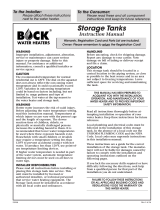 Bock Water heaters 30ST User manual
Bock Water heaters 30ST User manual
-
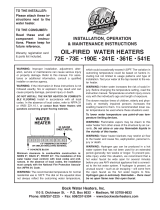 Bock Water heaters 361E User manual
Bock Water heaters 361E User manual
-
Bock Water heaters 72E Installation guide
-
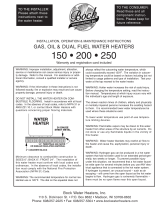 Bock Water heaters 250 User manual
Bock Water heaters 250 User manual
-
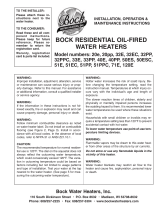 Bock Water heaters 32E User manual
Bock Water heaters 32E User manual
-
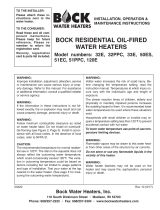 Bock Water heaters 32E Installation guide
Bock Water heaters 32E Installation guide
-
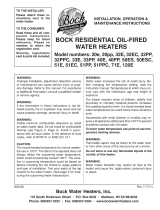 Bock Water heaters 32E User manual
Bock Water heaters 32E User manual
-
 Bock Water heaters OT300-A Installation And Operation Instruction Manual
Bock Water heaters OT300-A Installation And Operation Instruction Manual
-
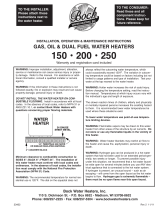 Bock Water heaters OT250 User manual
Bock Water heaters OT250 User manual
Other documents
-
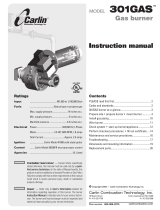 Carlin Combustion Technology 301 Installation guide
Carlin Combustion Technology 301 Installation guide
-
State Water Heaters TPO-140-140 User manual
-
BCS Boiler Oil-Fired User manual
-
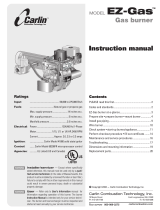 Carlin Combustion Technology EZ Installation guide
Carlin Combustion Technology EZ Installation guide
-
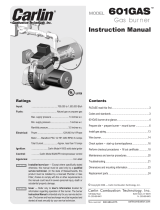 Carlin Combustion Technology 601 Installation guide
Carlin Combustion Technology 601 Installation guide
-
Midco Wi-Fi Pods Installation guide
-
Midco Fixed Wireless Adapter Wi-Fi Pods Installation guide
-
Smith Cast Iron Boilers JWF657 User manual
-
John Wood JWF657 Operating instructions
-
GSW JWF657 User manual






















